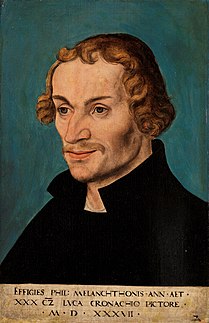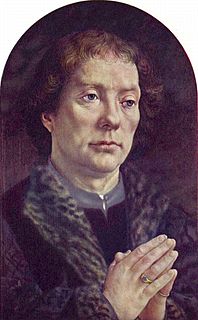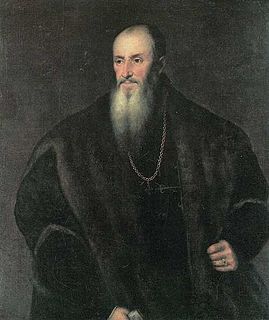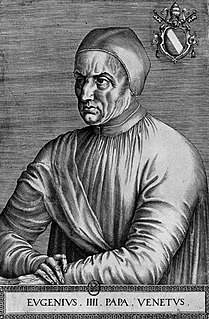
Philip Melanchthon was a German Lutheran reformer, collaborator with Martin Luther, the first systematic theologian of the Protestant Reformation, intellectual leader of the Lutheran Reformation, and an influential designer of educational systems. He stands next to Luther and John Calvin as a reformer, theologian, and moulder of Protestantism.

Isabella of Austria, also known as Elizabeth, Archduchess of Austria and Infanta of Castile and Aragon, was Queen of Denmark, Norway and Sweden as the consort of King Christian II. She was the daughter of King Philip I and Queen Joanna of Castile and the sister of Emperor Charles V. She was born at Brussels. She served as regent of Denmark in 1520.

Mary of Austria, also known as Mary of Hungary, was queen consort of Hungary and Bohemia as the wife of King Louis II, and was later Governor of the Habsburg Netherlands.

The Collegium Trilingue, often also called Collegium trium linguarum, or, after its creator Collegium Buslidianum, was founded in 1517 under the patronage of the humanist, Hieronymus van Busleyden.

Mercurino Arborio, marchese di Gattinara, was an Italian statesman and jurist best known as the chancellor of the Holy Roman Emperor Charles V. He was made cardinal of the Roman Catholic Church for San Giovanni a Porta Latina in 1529.

Viglius was the name taken by Wigle Aytta van Zwichem, a Dutch statesman and jurist, a Frisian by birth.
Francisco de Enzinas, also known by the humanist name Francis Dryander, was a classical scholar, translator, author, Protestant reformer and apologist of Spanish origin.

Jean II Carondelet, was a Burgundian cleric, politician, jurist and one of the most important advisors to Charles V, Holy Roman Emperor. He was a patron of Erasmus and a brother of Ferry Carondelet.

The European wars of religion were a series of Christian religious wars which were waged in Europe during the 16th, 17th and early 18th centuries. Fought after the Protestant Reformation began in 1517, the wars disrupted the religious and political order in the Catholic countries of Europe. However, religion was only one of the causes, which also included revolts, territorial ambitions, and Great Power conflicts. For example, by the end of the Thirty Years' War (1618–1648), Catholic France was allied with the Protestant forces against the Catholic Habsburg monarchy. The wars were largely ended by the Peace of Westphalia (1648), establishing a new political order now known as Westphalian sovereignty.

Jacobus Latomus was a Flemish theologian, a distinguished member of the Faculty of Theology at the University of Leuven. Latomus was a theological adviser to the Inquisition, and his exchange with William Tyndale is particularly noted. The general focus of his academic work centered on opposing Martin Luther and the Protestant Reformation, supporting the divine right of the papacy and the hierarchy of the Roman Catholic Church. Etymology: Latinized Latomus = Masson from Greek lā-tómos 'stone-cutter, quarryman', thus 'mason'.

Philip of Burgundy was Admiral of the Netherlands from 1498 to 1517 and bishop of Utrecht from 1517 to 1524.

Hieronymus van Busleyden was a patron of learning and a humanist from the Habsburg Netherlands. His name is usually partially Latinized in English, and can also appear as Hieronymus Busleyden or fully Latinized as Hieronymus Buslidius.

Nicolas Perrenot de Granvelle (1486–1550) was a Burgundian politician who served as a close trusted advisor to Emperor Charles V. He was made suzerain of the imperial city of Besançon and held an influential position in the Netherlands. From 1530 until his death he was one of the emperor's most trusted advisers in Germany. He was the father of the cardinal and politician Antoine Perrenot de Granvelle, also a leading Habsburg minister, and built the Palace Granvelle in Besançon.

The Old University of Leuven was established in 1425 with Faculties of Arts, Medicine, Law; however, the university did not have a Faculty of Theology initially. In 1426 a Faculty of Canon Law was added, and at that time both Law Faculties functioned together in one Collegium utriusque iuris.
Pierre Van Der Vorst was a Roman Catholic prelate who served as Bishop of Acqui (1535–1549). He was the son of Jean Van der Vorst, Seigneur of Loenbeke and Chancellor of Brabant for Charles V and Philip II, King of Castile. He served as a judge in the courts of the Roman Curia, and as ambassador of Pope Paul III to the German princes in negotiations for holding the Council of Trent.
Conrad Goclenius was a Renaissance humanist, and Latin scholar, and the closest confidant of humanist Desiderius Erasmus, who was born in Mengeringhausen in the Landgraviate of Hesse in 1490, and died in Leuven in January 25, 1539.

Schetz or Schetz de Grobbendonk, originally von Schetzenbergh is a German Noble House. Most famous is the Flemish branch named Schetz, one of whose members became the first duke of Ursel.

Frans van Cranevelt, also known as Franciscus Craneveldius, was a Flemish humanist and lawyer.
Johan Weze, also known as Johan von Weeze, was a secretary of King Christian II of Denmark and a diplomat at the service of the Holy Roman Emperor Charles V. In 1522, he was appointed Archbishop of Lund. He followed Christian II into exile but resigned as his secretary when Christian refused to follow the policies of his brother-in-law the Emperor Charles V. In 1527 Weze joined the service of the Emperor as a diplomat and participated in numerous missions in the Holy Roman Empire. He was appointed Prince Bishop of Constance in 1537, a post he held until his death in 1548.
Godschalk Ericksen, was Christian II of Denmark's chancellor and later a diplomat at the service of Emperor Charles V.



















